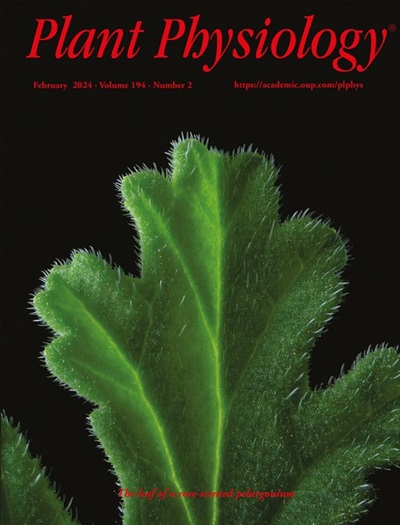水生被子植物蓝光受体隐色体(CRY1/2)的起源与进化
IF 6.5
1区 生物学
Q1 PLANT SCIENCES
引用次数: 0
摘要
隐色体(CRYs)负责感知植物体内的蓝光,在调节蓝光信号和昼夜节律方面起着至关重要的作用。然而,隐色体的功能并不局限于光探测,它们还能帮助植物适应压力,并可能帮助植物适应其他调节机制。水生被子植物是由不同的被子植物系独立进化而来的,与陆生被子植物相比,水生被子植物对水生栖息地独特的光质和环境压力有特殊的适应性。我们假设,被子植物 CRY1/2 的序列和调控网络在不同的水生被子植物系中经历了适应性进化。为了验证这一假设,我们汇编了由 55 个绿色植物基因组(包括 37 个被子植物基因组)、80 个被子植物转录组和 4 个被子植物表达网络组成的综合数据集。通过比较分析,我们发现CRY1起源于种子植物的共同祖先,而CRY2起源于陆生植物的共同祖先。在被子植物中,水生品系的 CRY1/2 序列表现出正向选择,而 CRY2 的保守缬氨酸-脯氨酸(VP)基序在两个水生物种中表现出趋同性缺失。与蓝光受体(CRY)相关的共表达基因显示出对水生环境的适应性,特别是与洪水和渗透压相关的适应性。这些发现揭示了 CRY1/2 的适应性进化,包括其起源、序列和调控网络。此外,这些结果为研究 CRY 的未表征功能和调控途径提供了宝贵的见解,并为提高农业植物的生长和适应性提供了潜在的目标。本文章由计算机程序翻译,如有差异,请以英文原文为准。
Origin and evolution of the blue light receptor cryptochromes (CRY1/2) in aquatic angiosperms
Cryptochromes (CRYs), which are responsible for sensing blue light in plants, play a critical role in regulating blue light signals and circadian rhythms. However, their functions extend beyond light detection, as they also aid plants in adapting to stress and potentially other regulatory mechanisms. Aquatic angiosperms, which independently evolved from various angiosperm lineages, have developed specific adaptations to unique light qualities and environmental stressors found in aquatic habitats compared to terrestrial ones. It was hypothesized that the sequences and regulatory networks of angiosperm CRY1/2 underwent adaptive evolution in different aquatic angiosperm lineages. To test this hypothesis, we compiled comprehensive datasets consisting of 55 green plant genomes (including 37 angiosperm genomes), 80 angiosperm transcriptomes, and 4 angiosperm expression networks. Through comparative analysis, we found that CRY1 originated from a common ancestor of seed plants, whereas CRY2 originated from a common ancestor of land plants. In angiosperms, the CRY1/2 sequences of aquatic lineages exhibited positive selection, and the conserved valine-proline (VP) motif of CRY2 showed a convergent loss in two aquatic species. Co-expressed genes associated with blue light receptors (CRY) showed adaptations to aquatic environments, specifically in relation to flooding and osmotic stress. These discoveries shed light on the adaptive evolution of CRY1/2, encompassing their origins, sequences, and regulatory networks. Furthermore, these results provide valuable insights for investigating the uncharacterized functions and regulatory pathways of CRY and offer potential targets for enhancing growth and adaptation in agricultural plants.
求助全文
通过发布文献求助,成功后即可免费获取论文全文。
去求助
来源期刊

Plant Physiology
生物-植物科学
CiteScore
12.20
自引率
5.40%
发文量
535
审稿时长
2.3 months
期刊介绍:
Plant Physiology® is a distinguished and highly respected journal with a rich history dating back to its establishment in 1926. It stands as a leading international publication in the field of plant biology, covering a comprehensive range of topics from the molecular and structural aspects of plant life to systems biology and ecophysiology. Recognized as the most highly cited journal in plant sciences, Plant Physiology® is a testament to its commitment to excellence and the dissemination of groundbreaking research.
As the official publication of the American Society of Plant Biologists, Plant Physiology® upholds rigorous peer-review standards, ensuring that the scientific community receives the highest quality research. The journal releases 12 issues annually, providing a steady stream of new findings and insights to its readership.
 求助内容:
求助内容: 应助结果提醒方式:
应助结果提醒方式:


